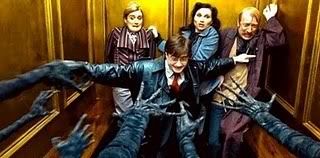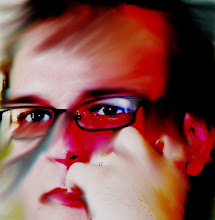Tuesday, November 30, 2010
David Lynch Music Video Contest!
Wow! This is the coolest thing I've seen in my life!
One of my honest to God heroes is holding a contest to write/direct/produce his music videos!
I didn't even know he was making a record!
I just peed my pants!
You can find the details on the contest here!
Now I have to come up with an idea!
You can tell I'm excited because I've ended every single sentence with an exclamation point!!!
Black Swan Trailer - I Hate Darren Aronofsky
I got very excited when I saw the trailer for "Black Swan." Then I saw that it was a film by Darren Aronofsky.

I hated "Requiem for a Dream" with a the wildest kind of vengeance.
I liked "Pi" the first time I saw it, but it does not stand up to repeated viewings.
The rest of his films have just bored me.
In a nutshell, Darren Aronofsky, in this snob's humble opinion, is a flashy, show-off who loves editing montages but can't tell a story or develop a character to save his life.
Just my opinion.
But "Black Swan" looks good. Dare I hope?
Dare I?
I really want to like this movie. I hope it's the exception to the Aronofsky rule.

I hated "Requiem for a Dream" with a the wildest kind of vengeance.
I liked "Pi" the first time I saw it, but it does not stand up to repeated viewings.
The rest of his films have just bored me.
In a nutshell, Darren Aronofsky, in this snob's humble opinion, is a flashy, show-off who loves editing montages but can't tell a story or develop a character to save his life.
Just my opinion.
But "Black Swan" looks good. Dare I hope?
Dare I?
I really want to like this movie. I hope it's the exception to the Aronofsky rule.
Monday, November 29, 2010
Nowhere Boy - Sam Taylor-Wood (2009)
John Lennon wasn’t just one of the most influential musicians of the last 50 years. He wrote words that became synonymous with peace.
 His childhood was lonely, so how could a film about his life be so excruciatingly tedious to sit through?
His childhood was lonely, so how could a film about his life be so excruciatingly tedious to sit through?
Boring sad childhood.
 Boring young lust.
Boring young lust.
 Aaron Johnson, who plays Lennon, sleepwalks through the entire film and he looks like he’s just about as bored as all of us are.
Aaron Johnson, who plays Lennon, sleepwalks through the entire film and he looks like he’s just about as bored as all of us are.
Boring, boring, contrived conflicted repeated in somewhat different settings.
“We’re horrible authority figures.”
“Well, I’m a young, rebellious whippersnapper, so watch it.”
Kirsten Scott Thomas plays John Lennon’s aunt, who raised the lad. His mother doesn’t live far, and John goes over to visit a lot.
Of course, there’s a whole lot of angst going on. Mostly about "Why, oh why did mummy give me up?"
SPOILER: It’s because Lennon’s aunt convinced Social Services that she should have custody because she was a single mother and loose women make bad mothers.
END SPOILER
Lennon’s step-common-law-father is played by David Morrissey. I wondered to myself why they bothered casting someone like David Morrissey in such a throwaway, routine, stock role.
Then, I wondered why they were making this movie in the first place.
 “Nowhere Boy” drags on for 45 minutes or so with no mercy killing in sight until finally John’s aunt buys him a guitar.
“Nowhere Boy” drags on for 45 minutes or so with no mercy killing in sight until finally John’s aunt buys him a guitar.
Never mind that it’s completely out of character for her.
Just thank God for the sake of the movie that she did so we can listen to the Quarrymen, Lennon’s pre-Beatles band, for a bit.
Along the way, on the music front, John meets a very young Paul McCartney, played by Thomas Sangster, best known for his stellar performance as the voice of “Ferb” from Disney’s animated series “Phineas and Ferb.”

Sadly, the music doesn’t last long and we’re back to the sad but monotonous life of the lad who would one day be John Lennon but for now, is just some kid living an angst-ridden life.
The rest of the movie follows the pattern of the first act.
More boring angst, followed by boring tragedy and then, young John is off to start a new band the screenwriters don’t mention the name of.
I assume they thought they were being clever.
If you're really bent on watching something about John Lennon or his music or anything related to the Beatles, watch "Hard Day's Night," "Yellow Submarine" or even Iain Softley's "Backbeat."
 Better yet, just go and listen to "Imagine" or "Double Fantasy."
Better yet, just go and listen to "Imagine" or "Double Fantasy."
Or watch an episode of "Phineas and Ferb." It doesn't have anything to do with John Lennon, but it's not nearly the waste of your time "Nowhere Boy" is.
 His childhood was lonely, so how could a film about his life be so excruciatingly tedious to sit through?
His childhood was lonely, so how could a film about his life be so excruciatingly tedious to sit through?Boring sad childhood.
 Boring young lust.
Boring young lust. Aaron Johnson, who plays Lennon, sleepwalks through the entire film and he looks like he’s just about as bored as all of us are.
Aaron Johnson, who plays Lennon, sleepwalks through the entire film and he looks like he’s just about as bored as all of us are.Boring, boring, contrived conflicted repeated in somewhat different settings.
“We’re horrible authority figures.”
“Well, I’m a young, rebellious whippersnapper, so watch it.”
Kirsten Scott Thomas plays John Lennon’s aunt, who raised the lad. His mother doesn’t live far, and John goes over to visit a lot.
Of course, there’s a whole lot of angst going on. Mostly about "Why, oh why did mummy give me up?"
SPOILER: It’s because Lennon’s aunt convinced Social Services that she should have custody because she was a single mother and loose women make bad mothers.
END SPOILER
Lennon’s step-common-law-father is played by David Morrissey. I wondered to myself why they bothered casting someone like David Morrissey in such a throwaway, routine, stock role.
Then, I wondered why they were making this movie in the first place.
 “Nowhere Boy” drags on for 45 minutes or so with no mercy killing in sight until finally John’s aunt buys him a guitar.
“Nowhere Boy” drags on for 45 minutes or so with no mercy killing in sight until finally John’s aunt buys him a guitar.Never mind that it’s completely out of character for her.
Just thank God for the sake of the movie that she did so we can listen to the Quarrymen, Lennon’s pre-Beatles band, for a bit.
Along the way, on the music front, John meets a very young Paul McCartney, played by Thomas Sangster, best known for his stellar performance as the voice of “Ferb” from Disney’s animated series “Phineas and Ferb.”

Sadly, the music doesn’t last long and we’re back to the sad but monotonous life of the lad who would one day be John Lennon but for now, is just some kid living an angst-ridden life.

The rest of the movie follows the pattern of the first act.
More boring angst, followed by boring tragedy and then, young John is off to start a new band the screenwriters don’t mention the name of.
I assume they thought they were being clever.
If you're really bent on watching something about John Lennon or his music or anything related to the Beatles, watch "Hard Day's Night," "Yellow Submarine" or even Iain Softley's "Backbeat."
 Better yet, just go and listen to "Imagine" or "Double Fantasy."
Better yet, just go and listen to "Imagine" or "Double Fantasy."Or watch an episode of "Phineas and Ferb." It doesn't have anything to do with John Lennon, but it's not nearly the waste of your time "Nowhere Boy" is.
Labels:
2009,
bad,
coming of age,
drama,
rebellion,
rock 'n roll
Monday, November 22, 2010
Grace – Paul Solet (2009)
Dear God, thank you for treating us to movies every once in a while that are just wrong in every way. “Grace” is Paul Solet’s feature film debut. Solet, isn’t someone you’ve heard of iunless you’re just the most obsessive horror movie fan in the universe, or maybe one of his friends or something.
“Grace” is Paul Solet’s feature film debut. Solet, isn’t someone you’ve heard of iunless you’re just the most obsessive horror movie fan in the universe, or maybe one of his friends or something.
He won “Fangoria Magazine’s” Best Short Horror Film of the Year Award in 2005 for his film, “Means to an End.”
It was amusing, but nothing earth-shattering. There was nothing in the film that would indicate he would go on to make such a wonderfully obscene and original first feature.
In a nutshell, “Grace” is about a cannibal baby.That’s right, this movie is about a baby that drinks blood. And of course, animal blood just won’t do. That would just turn into a short, boring movie really fast.
But “Grace” is wonderful and it is revolting. You have not seen breast feeding like this before.
 But that’s not even the best part. Neither the blood-sucking baby nor the mother who supplies the infant with God’s yummy, red innards-nectar is the creepiest character in the movie.
But that’s not even the best part. Neither the blood-sucking baby nor the mother who supplies the infant with God’s yummy, red innards-nectar is the creepiest character in the movie.

The baby has a grandma who’s almost demonically insane. I mean, she is just a treat to watch. When she finds out she’s going to be a grandmother, she does some research and discovers that women can lactate past menopause if their nipples get sufficient stimulation.
Of course, the crazy grandma gets excited about this and starts letting grandpa into her sweater full of goodies for the first time in God knows how long, just in the hopes of being able to breastfeed her grand-baby. Which of course, is more unsettling than the baby who drinks blood.
Now that’s a level of insanity you have to work at. God doesn’t just give that kind of crazy away.
So what we have here is Solet weaving together a tapestry of people behaving in just the most unimaginable ways.
First, we have the baby who has to have breast blood instead of breast milk.
 Then there’s the mother.
Then there’s the mother.
Let’s just say if you really like a sick thrill, like I do, it’s better for you go ahead and watch “Grace” then to have me explain how it all works here.
If you are the kind of person who’s just dying to have me describe how the mother gets Grace her blood, you’re probably the kind of person who's out there killing small animals, not the kind sitting at a computer, reading movie reviews.
 Then you have the just unbelievably insane grandmother who’s determined to make herself start lactating again so she can feed her grand-baby, but oh my God, she has no idea what she’s getting into.
Then you have the just unbelievably insane grandmother who’s determined to make herself start lactating again so she can feed her grand-baby, but oh my God, she has no idea what she’s getting into.
Add it all up and Solet serves up a recipe for a truly delightful 84-minute ick-fest.
If you like gross and you like “what is wrong with you lady” filmmaking, you really aren’t going to do a whole lot better than “Grace.”
 Solet doesn’t come near the level of Cronenberg when it comes to examining just what our relationships to these bizarre things we call bodies are. But that is a high watermark.
Solet doesn’t come near the level of Cronenberg when it comes to examining just what our relationships to these bizarre things we call bodies are. But that is a high watermark.
Cronenberg will always be the master of this kind of film, but “Grace” is more than worth a look, nevertheless.
 “Grace” is Paul Solet’s feature film debut. Solet, isn’t someone you’ve heard of iunless you’re just the most obsessive horror movie fan in the universe, or maybe one of his friends or something.
“Grace” is Paul Solet’s feature film debut. Solet, isn’t someone you’ve heard of iunless you’re just the most obsessive horror movie fan in the universe, or maybe one of his friends or something.He won “Fangoria Magazine’s” Best Short Horror Film of the Year Award in 2005 for his film, “Means to an End.”
It was amusing, but nothing earth-shattering. There was nothing in the film that would indicate he would go on to make such a wonderfully obscene and original first feature.
In a nutshell, “Grace” is about a cannibal baby.That’s right, this movie is about a baby that drinks blood. And of course, animal blood just won’t do. That would just turn into a short, boring movie really fast.
But “Grace” is wonderful and it is revolting. You have not seen breast feeding like this before.
 But that’s not even the best part. Neither the blood-sucking baby nor the mother who supplies the infant with God’s yummy, red innards-nectar is the creepiest character in the movie.
But that’s not even the best part. Neither the blood-sucking baby nor the mother who supplies the infant with God’s yummy, red innards-nectar is the creepiest character in the movie.
The baby has a grandma who’s almost demonically insane. I mean, she is just a treat to watch. When she finds out she’s going to be a grandmother, she does some research and discovers that women can lactate past menopause if their nipples get sufficient stimulation.
Of course, the crazy grandma gets excited about this and starts letting grandpa into her sweater full of goodies for the first time in God knows how long, just in the hopes of being able to breastfeed her grand-baby. Which of course, is more unsettling than the baby who drinks blood.
Now that’s a level of insanity you have to work at. God doesn’t just give that kind of crazy away.
So what we have here is Solet weaving together a tapestry of people behaving in just the most unimaginable ways.
First, we have the baby who has to have breast blood instead of breast milk.
 Then there’s the mother.
Then there’s the mother. Let’s just say if you really like a sick thrill, like I do, it’s better for you go ahead and watch “Grace” then to have me explain how it all works here.
If you are the kind of person who’s just dying to have me describe how the mother gets Grace her blood, you’re probably the kind of person who's out there killing small animals, not the kind sitting at a computer, reading movie reviews.
 Then you have the just unbelievably insane grandmother who’s determined to make herself start lactating again so she can feed her grand-baby, but oh my God, she has no idea what she’s getting into.
Then you have the just unbelievably insane grandmother who’s determined to make herself start lactating again so she can feed her grand-baby, but oh my God, she has no idea what she’s getting into.Add it all up and Solet serves up a recipe for a truly delightful 84-minute ick-fest.
If you like gross and you like “what is wrong with you lady” filmmaking, you really aren’t going to do a whole lot better than “Grace.”
 Solet doesn’t come near the level of Cronenberg when it comes to examining just what our relationships to these bizarre things we call bodies are. But that is a high watermark.
Solet doesn’t come near the level of Cronenberg when it comes to examining just what our relationships to these bizarre things we call bodies are. But that is a high watermark.Cronenberg will always be the master of this kind of film, but “Grace” is more than worth a look, nevertheless.
Sunday, November 21, 2010
David Yates Talks About "Deathly Hallows:" the Second Interview
Okay, in the first interview, we heard Yates talk about Rupert Grint's performance, Hermione's character coming into her own and the animated sequence that told the story of the three brothers and the Deathly Hallows. 
Yates also talked about the dance scene between Harry & Hermione. This scene is small, but it's important and wonderful.
It gets so much across. There's so much relief and camaraderie as the two friends forget their troubles and dance together.
But Yates doesn't cut out like most directors would. We see the end of the scene as it would happen in real life.
The dance fades and the moment is slowly lost and the two are pulled slowly back into reality and into their struggle.
It is a perfect scene and if I might say so, Yates chose a perfect song with Nick Cave & the Bad Seed's "O Children." When Cave talks of singing and rejoicing, there is a bitterness and a cynicism that goes along with his sorrowful hope.
It's the perfect match for what these characters are going through.

Yates also talked about the dance scene between Harry & Hermione. This scene is small, but it's important and wonderful.
It gets so much across. There's so much relief and camaraderie as the two friends forget their troubles and dance together.
But Yates doesn't cut out like most directors would. We see the end of the scene as it would happen in real life.
The dance fades and the moment is slowly lost and the two are pulled slowly back into reality and into their struggle.
It is a perfect scene and if I might say so, Yates chose a perfect song with Nick Cave & the Bad Seed's "O Children." When Cave talks of singing and rejoicing, there is a bitterness and a cynicism that goes along with his sorrowful hope.

It's the perfect match for what these characters are going through.
Labels:
2010,
art,
children,
coming of age,
dark,
drama,
fascism,
literature,
revenge
David Yates Discusses Animated Sequence in "Harry Potter & the Deathly Hallows: Part 1"
 |
| Photo Courtesy: Warner Bros. Pictures |
That bit is toward the end, but the whole interview is worth a listen.
Labels:
2010,
animation,
art,
children,
coming of age,
dark,
literature
Thursday, November 18, 2010
Tuesday, November 16, 2010
Harry Potter and the Deathly Hallows: Part 1 – David Yates (2010)
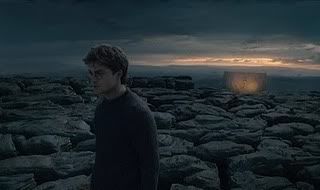
When I learned after “Goblet of Fire,” that some unknown television director named David Yates was going to take the helm of “Harry Potter and the Order of the Phoenix,” I wasn’t just apprehensive. I was disappointed. Annoyed even.
After seeing it, I was relieved. “Order” was the best Potter movie yet. Still, I wasn’t thrilled that Yates would be directing “Half-Blood Prince.” But Yates proved himself up to the task. When I walked out of the advance press screening for “Harry Potter and the Deathly Hallows: Part 1,” I was convinced that David Yates might be one of the finest filmmakers of this generation.
Part of me will be sorry to see the series go, but I’m truly excited to see what kind of career Yates has beyond the Harry Potter franchise. I’m dying to see what kind of movies he ends up making.
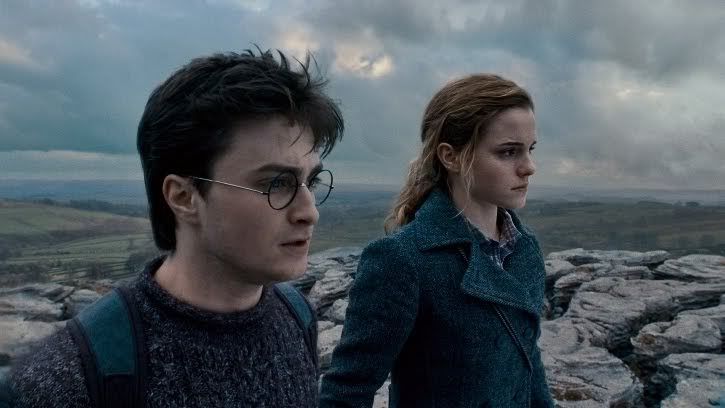
I went to the advance press screening of “Harry Potter and the Deathly Hallows: Part 1” this week and I can tell you I haven’t seen a film in a very long time that uses animation and special effects so brilliantly, yet sparingly. The animation is so unbelievably vivid, yet so subtle it’s barely noticeable at the same time. The reason for that is that the effects in “The Deathly Hallows” truly serve the story, characters and emotional impact of the film.
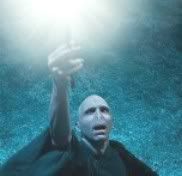 Almost every other movie a major studio cranks out takes the opposite approach where the story is there as a flimsy justification for showcasing whatever cool effects the audience wants to be wowed by. In “Harry Potter and the Deathly Hallows,” the story, character development and emotional impact of the film are already a solid foundation for everything else to dance on.
Almost every other movie a major studio cranks out takes the opposite approach where the story is there as a flimsy justification for showcasing whatever cool effects the audience wants to be wowed by. In “Harry Potter and the Deathly Hallows,” the story, character development and emotional impact of the film are already a solid foundation for everything else to dance on.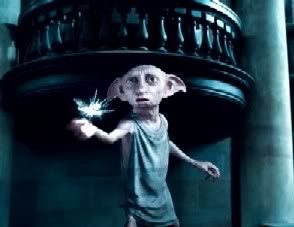 Even without any effects or even magic, we’d be left with an exceptionally compelling drama with absorbing and conflicted characters. The animation and effects come in and serve the story instead of being the superfluous eye-candy audiences have become used to. It might sound like a contradiction to rejoice in how masterfully the animation was used in a film by saying that it wasn’t essential, but that’s just how carefully the effects are woven into this story.
Even without any effects or even magic, we’d be left with an exceptionally compelling drama with absorbing and conflicted characters. The animation and effects come in and serve the story instead of being the superfluous eye-candy audiences have become used to. It might sound like a contradiction to rejoice in how masterfully the animation was used in a film by saying that it wasn’t essential, but that’s just how carefully the effects are woven into this story.When Harry, Ron and Hermione interact, they do so on human terms. They are away from the visual opulence of Hogwarts and cinematographer Eduardo Serra keeps the look of the film as non-magical as possible, using the rugged look to remind us just how much these young wizards are out of their element.
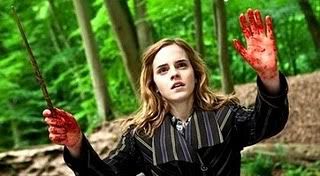 This is Serra’s first Harry Potter film and it’s clear he was picked precisely because he’s not an effects-driven cinematographer. Serra is known for creating stunning pictures with very little backdrop, working with filmmakers like Claude Chabrol, Patrice Leconte, and Ian Softley. And that’s why, when the animation is brought in, it has so much power. When we see an effect, it’s for a reason, in “Deathly Hallows,” often to express the rage or despair of one of the characters.
This is Serra’s first Harry Potter film and it’s clear he was picked precisely because he’s not an effects-driven cinematographer. Serra is known for creating stunning pictures with very little backdrop, working with filmmakers like Claude Chabrol, Patrice Leconte, and Ian Softley. And that’s why, when the animation is brought in, it has so much power. When we see an effect, it’s for a reason, in “Deathly Hallows,” often to express the rage or despair of one of the characters.In another scene, Harry finds the graves of his parents and knees in front of their headstones. Hermione takes a place beside her friend, pulls her wand out and creates a beautiful wreath that’s now lying at their grave.
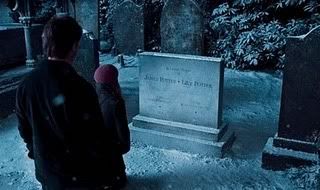 It’s the perfect example of animation, and imagination being used to convey the most sincere emotion. It parallels the way in the wizarding world the way magic can be used to express the most profound sorrow, joy or comfort.
It’s the perfect example of animation, and imagination being used to convey the most sincere emotion. It parallels the way in the wizarding world the way magic can be used to express the most profound sorrow, joy or comfort.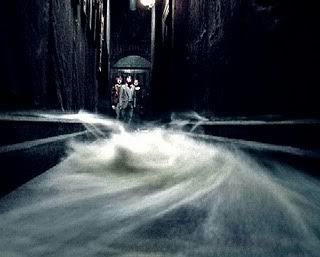 In another effects-driven, Harry and Ron destroy a Horcrux. (If you’re not a Potter fan and don’t know what that is, I’m not going to spend a lot of time explaining it to you. It’s an enchanted locket. There.) What comes out of the cursed object is Ron Weasley’s worst fears and deepest insecurities expressed through a wonderfully dismal and frightening animated sequence.
In another effects-driven, Harry and Ron destroy a Horcrux. (If you’re not a Potter fan and don’t know what that is, I’m not going to spend a lot of time explaining it to you. It’s an enchanted locket. There.) What comes out of the cursed object is Ron Weasley’s worst fears and deepest insecurities expressed through a wonderfully dismal and frightening animated sequence.The real treat for aficionados of animation comes when it’s time for some good, old-fashioned back story. We hear the story of the three brothers who met Death and were given the “Deathly Hallows.” Hermione reads Harry and Ron the story from a children’s book while we’re treated to an animated short within the film that might be one of the most morbid, darkest little cartoons I’ve ever seen. It’s so wonderful and a perfect way to fill the audience in on the background of the story behind the legend of the very real magic they’re fighting against.
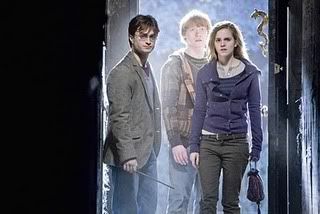 This cartoon alone is worth the price of admission, but really, the entire movie is simply wonderful. There is sadness and a joy in every look, touch and tone of voice when these three lifelong friends have any sort of exchange. The characters and the films have so many layers now, the storytelling is so rich that, visual effects aside, “Deathly Hallows” is just an incredible film.
This cartoon alone is worth the price of admission, but really, the entire movie is simply wonderful. There is sadness and a joy in every look, touch and tone of voice when these three lifelong friends have any sort of exchange. The characters and the films have so many layers now, the storytelling is so rich that, visual effects aside, “Deathly Hallows” is just an incredible film.
Labels:
2010,
animation,
art,
coming of age,
dark,
fascism,
literature
Sunday, November 14, 2010
The Girl Who Kicked The Hornet's Nest - Daniel Alfredson (2010)
 "The Girl Who Kicked the Hornet's Nest" does lack the bite of "The Girl With the Dragon Tattoo," but it's a more than fitting end to the Millennium Trilogy.
"The Girl Who Kicked the Hornet's Nest" does lack the bite of "The Girl With the Dragon Tattoo," but it's a more than fitting end to the Millennium Trilogy.Here's my video review.
Labels:
2010,
art,
crime,
fascism,
literature,
political,
rebellion,
revenge,
sadism,
video review,
violence,
women
Tuesday, November 9, 2010
"Never Let Me Go" Video Review
Labels:
2010,
art,
children,
coming of age,
dark,
drama,
fascism,
literature,
oscars,
political,
psychological thriller,
rebellion,
religion,
romance,
sci-fi,
sex,
video review
Sunday, November 7, 2010
Subscribe to:
Posts (Atom)


